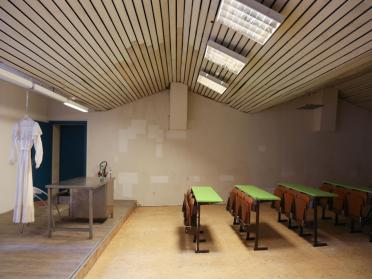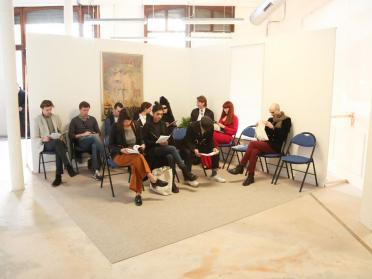
The Vestoj Storytelling Salon, April 5th 2014 with Jean-Charles de Castelbajac, Frances Corner, Simon Costin, Michele Lamy, Ingmari Lamy and Irene Silvagni, Lafayette Anticipations, Paris
The power of memories of clothes, which can be like Proust’s Madeleine for a single individual or for a whole epoch, was put to the test at the “Vestoj Salon”, hosted by Anja Aronowsky Cronberg. In Paris, the 5th of April 2014, seven fashion professionals addressed the public with personal stories linked to the memory of an item of clothing.
Their autobiographical keepsakes were spread around the building of the Fondation Galeries Lafayette, prey to the attention of the wandering audience. These stories which, back to back, perhaps formed a single one, were written on the basis of unique memories. Evoking, one after the other, nostalgia or inheritance, they gave the memory of each narrator a shape and a substance. Genuine memento mori textiles, the objects evoked often confirmed the intuition of Victor Hugo that history is an echo of the past resonating in the future.
The “Vestoj” stories, offered and repeated to small audiences — themselves launched one behind the other in a narrative survey — blurred the line between storyteller and spectator. Each story, made for a restricted public, was also inbuilt with a certain promiscuity, covered with empathy. What did it cost Jean-Charles de Castelbajac, Irene Silvagni or Frances Corner, public personalities revered in their profession, to recount their faith, their pain and their intimate memories in front of perfect strangers? A chasuble designed for the Pope, a lace wedding dress bought second hand, the jacket of a father who left to never return: so many stories sewn together with kindness. From what cloth was the Swedish model Ingmari Lamy cut, coming to tell visitors about the regrets of her unrequited love story with photographer Bob Richardson? These words were not only spoken, they were transmitted. Their rhythm, their intonation, their variation, throughout the day, depending on the reactions of the listeners who, through their complicit silence, became co-writers.
Fashion, uprooted from the logic of seasons and collections, was spoken instead of shown, listened to instead of worn. Even more, the experience of “The Vestoj Storytelling Salon” revealed how much clothing participates in the creation of identities. Too small or too big, or just passé, what we no longer wear but what we keep nonetheless, can help us make over our tired appearances.

The Vestoj Storytelling Salon, Jean-Charles de Castelbajac, April 5th 2014, Lafayette Anticipations, Paris

The Vestoj Storytelling Salon, Ingmari Lamy, April 5th 2014, Lafayette Anticipations, Paris

The Vestoj Storytelling Salon, April 5th 2014, Lafayette Anticipations, Paris

The Vestoj Storytelling Salon, April 5th 2014, Lafayette Anticipations, Paris

The Vestoj Storytelling Salon, Frances Corner, April 5th 2014, Lafayette Anticipations, Paris

The Vestoj Storytelling Salon, Michele Lamy, Anja Aronowsky Cronberg, April 5th 2014, Lafayette Anticipations, Paris
